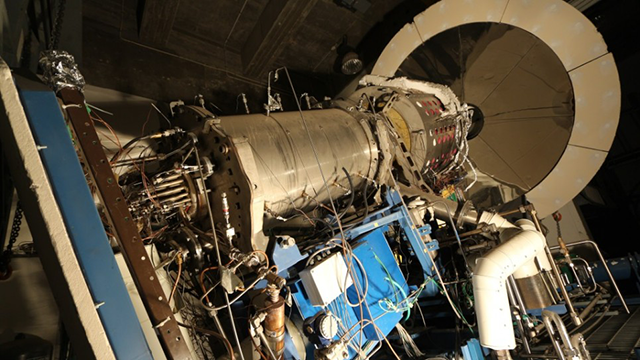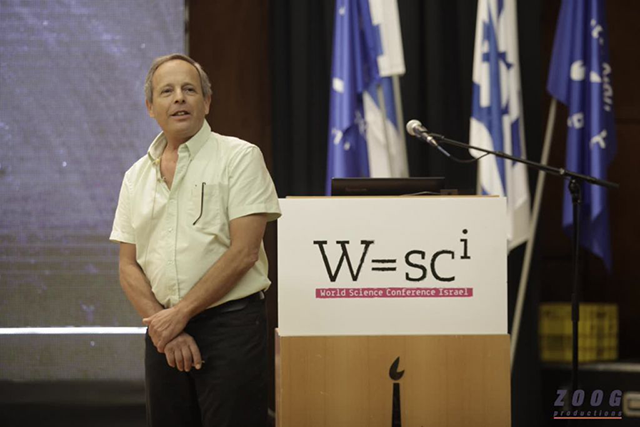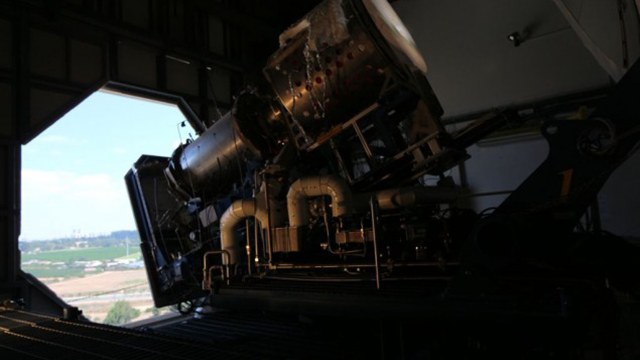A Weizmann professor and an entrepreneur have patented a device that extracts carbon dioxide from the atmosphere and turns it into fuel. They say it has the potential to save life on our planet

If this past summer felt hot to you, it’s not your imagination. Meteorologists predict that 2015 will end up being the hottest year on record. There is scientific consensus that the culprit is global warming, caused by carbon dioxide emissions.
Nevertheless, global warming is a hairtrigger issue and that’s because combustion, the chemical reaction responsible for modern industry, produces carbon dioxide (CO2), and carbon dioxide produces global warming. It’s a fact of nature that we can’t wish away, yet we’re unwilling to give up the modern comforts of electricity, automobiles, skyscrapers and advanced technology. Humanity is caught in a tragedy of its own making – our greatest achievements could soon lead to our biological extinction.
Or maybe not.
If only we could get rid of all the carbon dioxide in the atmosphere by converting it back into hydrocarbons and oxygen – a kind of reverse combustion – the earth could be saved. Of course that requires energy, which is the reason we burned the fuel in the first place. Is it possible to bend the laws of nature and get something for nothing?
That is precisely what an Israeli company, New CO2 Fuels, proposes to do. Based on research developed by Weizmann Institute Earth Sciences Professor Jacob Karni, the company takes captured CO2 and uses renewable energy to convert it back into fuel, reducing the need for fossil fuel extraction and reducing CO2 emissions. Not only that, but the process is profitable.
How the internal combustion engine upset the earth’s balance
David Banitt, the company’s CEO and co-founder, explains that all our climate problems began with the internal combustion engine.
Up until 150 years ago, he explains, the earth existed in a kind of harmony.

David Bannit
“Our bodies absorb oxygen and combine it with the food we eat to produce energy. We emit carbon dioxide when we breathe. But the carbon dioxide breathed out by animals is absorbed by plants and trees. Using the energy of the sun, they convert it back into carbon (carbohydrates) which makes their trunk and branches, and they emit oxygen back into the atmosphere.”
This natural balance, says Banitt, was first disturbed when our human ancestors made fire, combining the carbon in firewood with oxygen in the air to produce energy and CO2. But the amounts of excess CO2 were very small and nature adjusted itself.
Once we started burning coal and oil, however, there were not enough plants to absorb all the excess CO2.
“The quantities are immense. At present humanity is emitting 40 billion tons of CO2 per year above the natural balance. The problem is that CO2 gas emitted into the atmosphere creates a kind of blanket that prevents heat from leaving the atmosphere to go into space, and this is causing temperatures to rise slowly, which is climate change.”
About twenty years ago, says Banitt, scientists developed technologies to capture up to 90 percent of CO2 emissions before they hit the atmosphere.
“But the technology is expensive, and then you have 40 billion tons of carbon dioxide each year. What do you do with it? The original idea was to bury it in geological formations, but that’s like setting a bomb to go off 200 years from now.”
Indeed, some scientists argue that burying carbon dioxide can trigger earthquakes and that even a small earthquake can cause leaks that will defeat the purpose of the burial.
According to Banitt, there are a handful of companies worldwide that allow you to do something useful with the carbon dioxide you’ve captured. New CO2 Fuels allows you to get rid of the carbon dioxide and make money in the process.
“We basically recycle the carbon dioxide.”
What New CO2 Fuels does is reverse the combustion process. It takes CO2 and extracts the oxygen by injecting energy into it.
“We extract the oxygen – which is a good product in its own right. We’re left with carbon monoxide (CO) and hydrogen. That’s a gas known as syngas (synthetic gas) and there are lots of people around the world who know how to convert it into methanol, ethanol, gasoline, kerosene ammonia, urea, plastics, you name it.”
Where do you get the energy to do this?
“We can take it from the sun. And there are many industries producing a lot of heat that gets wasted. For instance, steel mills burn a lot of coal and gas to melt the ore. It’s the same with glass, cement and other metals.”

One of two prototypes of the machine that converts heat and carbon dioxide into oxygen and fuel.
Bannit says it’s a no-brainer for a steel mill to use his technology.
“You have a lot of heat that you’re wasting. You have a lot of CO2 that the regulator is pressuring you to reduce. Instead of wasting both of them, put them into our system and generate fuel, plastic or fertilizers.”
Yes, but if people go out and burn those fuels how are you reducing CO2 emissions?
“Imagine a steel plant that emits 10 million tons of CO2 per year. The plant is next to a town with 20,000 cars that emit another million tons of CO2 per year. Instead of buying oil from the oil company, the city can buy fuel from the steel mill which it generated using its heat and CO2. Previously, you had 11 million tons of carbon dioxide emissions. Now you take a million tons of CO2 from the steel mill and convert it back to fuel. So you only have 10 million tons of emissions.”
The gift of photosynthesis
In other words, New CO2 Fuels’ process is a kind of artificial photosynthesis. Just as plants take carbon dioxide and heat from the sun and turn them into oxygen and stored energy, New CO2 Fuels does the same, but at a much faster rate than nature. Just as photosynthesis is nature’s gift to humans and animals, the ultimate something for nothing, NCFs technology, if it scales, may just let us burn our fossil fuels and have them too.
According to Bannit a “standard” steel mill that produces 5 million tons of steel a year wastes 500 MW of heat and emits about 9 million tons of CO2 (or almost double the amount of CO2 compared to steel).
“If all the heat is made available to our system and in case we produce methanol (which means that part of the energy is used to dissociate water) then we will process 5% of the CO2 emission. However, if the system is used to dissociate only CO2 then it would be 15%. These are very large numbers. Steel makers hearing much more modest figures such as 2% are extremely happy. The goal for steel makers in Korea is to reduce their emissions by 6% by 2020.”
However, says Bannit, because his system can use both waste heat and renewable electricity, if it gets electricity from photovoltaics or wind then theoretically it could convert all of a plant’s emissions.
New CO2 Fuels has a handful of competitors, including CRI in Iceland, which uses geothermal energy to produce methanol, and U.S.-based Liquid Light. Bannit says Professor Jacob Karni’s patented technology allows NCF to convert CO2 into fuel more efficiently and at lower cost than the others.
In 2014, New CO2 Fuels won the prestigious World Technology Award, presented at the UN, in the corporate energy category. The company has received several grants from the Israeli government’s Alternative Fuels Administration. So far, they have two working prototypes and are set to launch in a year and a half at two industrial plants in Europe and Israel.”
“We’ve had $12 million in funding so far and we are looking for more,” Bannit pitches. “The prototypes are expensive and testing is expensive. We’re looking for another $10 million, and $6 million after that.”
A future of renewable fuel
“Right now we’re targeting steel mills,” says Bannit, “but in the future imagine our units working in the desert, with only the sun as a source of energy and CO2 from the plain atmosphere. We can generate fuel. It’s a closed loop.”
Why not use renewable energy to begin with?
“Humanity will not give up fuel; it cannot. The sun and wind are not always there when you need them. But if we can do it from totally renewable energy and CO2 from the atmosphere, then instead of burning fuel, we will recycle it all from renewable energy.”
